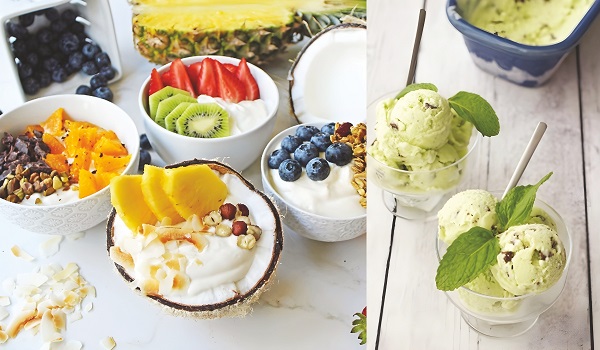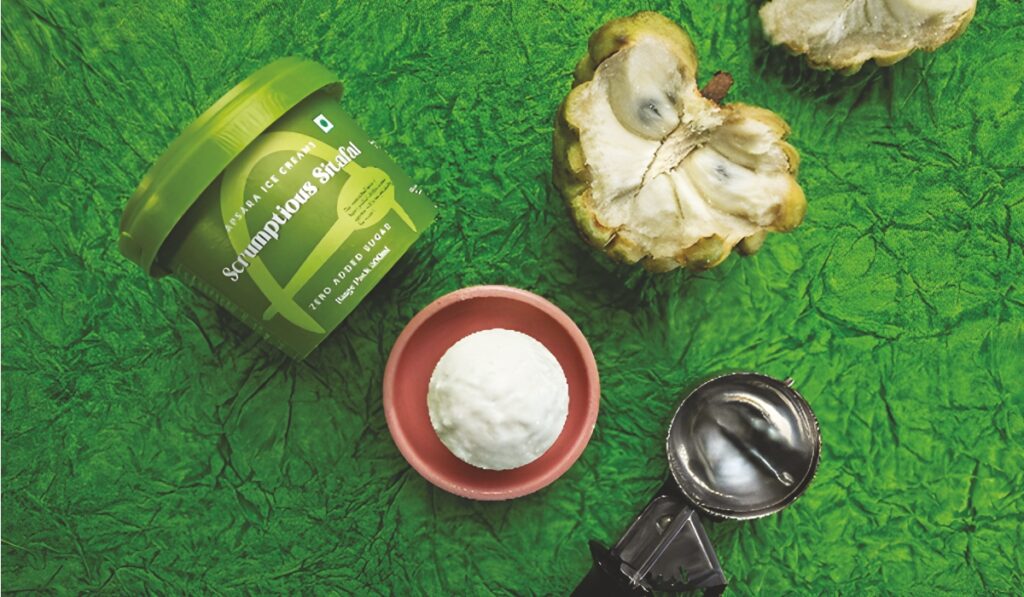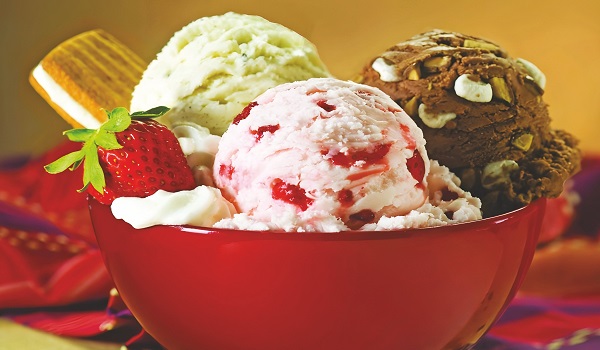In recent years, ice cream has undergone a big change. As people in India become more health-conscious, they’re looking for ice cream that’s not just delicious but also better for their health. This shift is part of a larger trend where people are more aware of what they eat and want to find a balance between enjoying their food and staying healthy.
Healthy ice creams, or “better-for-you” ice creams, are leading this change. Unlike traditional ice creams, which often have lots of sugar and fat, these new options focus on natural ingredients, lower calories, and cater to various dietary needs. This includes using natural sweeteners, adding protein, or offering vegan choices. The market for these healthier options is growing as more people look for treats that fit their health goals.

Ice cream experts like Keyur Shah, Partner Apsara Ice Cream, Mumbai; Hashim Basheer-Lead Consultant Wide Verticals, Kochi, Kerala; and Aditya Tripathi, MD, Cold Love Ice Cream, Delhi share their insights on why healthy ice creams are becoming so popular. They discuss the key ingredients driving this trend, the most popular flavours, and how the taste and texture of these ice creams compare to traditional ones. Their perspectives help explain how healthy ice creams are changing the dessert landscape and why they’re becoming a preferred choice for many people.
What key ingredients are driving the popularity of health ice creams among consumers?
Healthy ice creams are gaining popularity in India due to a mix of appealing ingredients and changing consumer habits. Keyur explains that natural ingredients like fruits, nuts, and natural sweeteners (like stevia or honey) attract those seeking fewer artificial additives.
i). Natural Ingredients: Healthy ice creams often highlight the use of natural ingredients such as fruits, nuts, and natural sweeteners like stevia or honey. These ingredients appeal to consumers looking for products with fewer artificial additives.
ii). Health Consciousness: There is a growing awareness of health and wellness among Indian consumers, leading them to seek healthier/better alternatives to traditional ice creams that are often high in sugar and fat.

iii). Low-Calories and Sugar Content: Many healthy ice creams are marketed as low in calories and sugar, catering to consumers who are mindful of their calorie intake and sugar consumption.
iv). Brand Credibility: Consumers are more likely to trust brands that emphasize quality, transparency in ingredients, and a commitment to health and sustainability.
v). Dietary Restrictions: With an increasing number of consumers following specific diets (e.g., Low calorie, gluten-free, vegan), healthy ice creams that cater to these dietary preferences have gained much popularity over a period of time.
Hashim somewhat combines ICT’s first and second questions and offers his feedback. “High-protein ice creams using ingredients like whey protein or Greek yogurt are becoming popular for health-conscious consumers. Low-sugar options sweetened with natural substitutes like erythritol are also trending.

According to him, health ice creams are trending based on the following criteria:
High-Protein Ice Creams: These are packed with protein and often use ingredients like whey protein isolate or Greek yogurt as a base. Popular flavors include chocolate, vanilla, and peanut butter.
Low-Sugar Ice Creams: Sweetened with natural sweeteners like stevia, erythritol, or monk fruit, these cater to those seeking to reduce sugar intake. Popular flavors include berries, mint chocolate chip, and cookies and cream.
Vegan Ice Creams: Made with plant-based milks like almond milk, coconut milk, or oat milk, these are popular with vegans and those with dairy restrictions. Popular flavors include chocolate, strawberry, and mango.
Superfood-Infused Ice Creams: These incorporate ingredients like acai, matcha, or goji berries for a health boost.
Unique Flavor Combinations: Adventurous health ice cream brands are creating exciting flavor combinations that cater to a variety of palates. Think dark chocolate sea salt, lavender honey, or pistachio rosewater.

To this, Aditya provides another perspective, observing that while the healthy ice cream market is growing, the bulk of their sales still come from traditional ice creams made with milk, cream, and sugar. “In our experience, the demand for healthy ice creams is relatively limited, compared to those who still treat ice cream as an indulgence”.
“Sugar-free is a large category for us and Vegan is growing, but the bulk of our sale is still ice cream made with milk, cream and sugar. We intentionally keep our sweetness levels low so that customers can taste the actual flavour of the ice cream”, informed Aditya.
What are the most popular flavours and varieties of health ice creams currently trending?
“In India, the popularity of healthy ice creams has led to a variety of flavours and varieties that cater to the tastes and preferences of health-conscious consumers”, observed Keyur. According to him, some of the most popular flavours and varieties currently trending include:
a). Fruit-Based Flavours: Ice creams made with real fruit extracts or chunks are highly popular. Common flavours include Mango, Strawberry, Custard Apple, Lychee, Coconut, Guava, Pineapple. Apsara’s Guava Glory is the best seller in India, and was also featured in Taste Atlas’s 2023 list of 100 Most Iconic Ice creams in the world.

b). Nutty Flavours: Varieties that incorporate nuts such as almonds, cashews, and pistachios are favoured for their crunchy texture and nutty flavour profiles. Our Roasted Almond ice cream is also a best seller.
c). Low-Calorie Options: Varieties specifically marketed as low-calorie or zero added sugar, appealing to consumers watching their calorie intake. We have our Zero Added Sugar range to cater to consumers who avoid sugar.
d). Dairy-Free and Vegan Options: Sorbets made without dairy catering to lactose-intolerant individuals and vegans.
e). Natural Sweeteners: Varieties sweetened with natural sweeteners like Stevia, FOS (Fructo-oligosaccharides), Honey, appealing to consumers looking to reduce their consumption of refined sugars. We use FOS because it doesn’t leave a bitter After-taste in the mouth like Stevia does.
Hashim adds that unique and adventurous flavour combinations are also gaining popularity. Flavours such as dark chocolate sea salt, lavender honey, and pistachio rosewater are appealing to consumers looking for new taste experiences.
Speaking about the most popular flavours and varieties of health ice creams currently trending, then even within our low calorie and sugar-free category, Chocolate is always very popular, as are fruit flavours, especially when they are season”, stated Aditya.
How do consumers perceive the taste and texture of healthy ice creams compared to traditional ice creams?
“The taste and texture of healthy ice creams tend to be a mixed bag compared to traditional ice creams. Below mentioned are breakdown”, comments Keyur.
Traditional Ice Cream:
◆ Taste: Rich, creamy, intense flavours often achieved with sugar, artificial flavours, and sometimes added fat. This creates a familiar, indulgent taste many associate with ice cream.
◆ Texture: Smooth, airy, and quick to melt due to higher air content and lower milk fat content compared to full-fat ice cream.
Healthy Ice Cream:
◆ Taste: Can be perceived as less sweet due to the use of sugar substitutes like stevia or FOS. The natural flavours of some ingredients might be more prominent. Some find this refreshing, while others miss the intense sweetness of traditional ice cream.
◆ Texture: Can vary depending on the ingredients. Some healthy ice creams use alternative bases like nut butter or coconut milk, leading to a denser texture compared to traditional ice cream. They might also have an icier texture due to less fat and different stabilizers.
Here’s the consumer perception in a nutshell:
◆ Traditional: Indulgent, familiar taste and texture.
◆ Health: Can be seen as a less-guilty indulgence, but the taste and texture might take some getting used to for those accustomed to traditional ice cream.
Additional factors:
◆ Price: Healthy ice cream is often more expensive than traditional options.
◆ Availability: Traditional ice cream is widely available, while healthy ice cream might be limited to specific stores or online retailers.
“The perception of taste and texture is a common concern for health ice creams”, Hashim explained. “Traditional ice creams are known for their rich, creamy texture and decadent flavours achieved with higher fat content and sugar. Healthier alternatives may use lower-fat ingredients and sugar substitutes, which can lead to a perception of being less creamy, icier, or having a different mouthfeel. However, many brands are innovating with ingredients and formulations to create healthier options that rival traditional ice cream in terms of taste and texture’.
“Taste and texture are very important” asserted Aditya. “Many brands we have tried have poor taste or texture because they are using alternative ingredients, but our experience says that a customer will not have a sub-standard product if they are health-conscious – they will find another brand or not have ice cream at all, if it doesn’t meet the basic taste and quality expectations”, well said by Aditya.
What factors influence consumer preference for healthy ice creams, such as ingredients, nutritional benefits, or brand reputation?
Further to the subject discussion, Keyur adds that in India, consumer preference for healthy ice creams is influenced by several key factors related to ingredients, nutritional benefits, and brand reputation:
Ingredients:
• Natural and Clean Ingredients: Consumers prefer healthy ice creams made with natural ingredients such as fruits, nuts, natural sweeteners like honey or FOS, and no artificial flavours, preservatives or colours.
• Added Health Benefits: Health-conscious consumers look for ice creams enriched with additional health benefits such as added protein, fiber, vitamins, minerals, or probiotics.
These additions enhance the nutritional profile and appeal of the product.
Nutritional Benefits:
Calorie Consciousness: Consumers are increasingly aware of calorie intake and prefer health ice creams that provide indulgence with fewer calories per serving compared to regular ice creams.
Brand Reputation:
• Trustworthiness and Transparency: Consumers place value on brands that are transparent about their sourcing practices, manufacturing processes, and ingredient sourcing. Trustworthy brands that maintain high standards in health and quality are preferred.
• Perception of Quality: Premium brands or those with a longstanding reputation for quality and innovation in healthier food options tend to attract discerning consumers willing to pay a premium for perceived higher quality.
According to Hashim, the factors that consumers consider when choosing health ice creams include a combination of certain facts like:
• Nutritional Benefits: High protein content, low sugar content, and use of natural sweeteners are all attractive qualities.
• Ingredients: Organic ingredients, superfoods, and an absence of artificial flavours or colours are appealing to health-conscious consumers.
• Brand Reputation: Brands that promote healthy eating and are transparent about their ingredients tend to be more trusted.
Aditya is exploring the exact factors influencing consumer preference for health ice creams but acknowledges that they could include aspects such as ingredients, nutritional benefits, and brand reputation.
5. What demographic groups are most likely to purchase health ice creams, and what factors influence their choices?
The Indian the market for healthier ice creams typically attracts certain demographic groups and is influenced by several factors, Keyur gives a detailed info:
Demographic Groups:
• Urban Middle-Class Consumers: This group is more health-conscious and has disposable income to spend on premium and healthier food options.
• Young Adults and Millennials: This demographic is increasingly concerned about health and fitness, seeking out products that offer health benefits without compromising on taste.
• Health-Conscious Families: Families with children, especially in urban areas, are concerned about nutrition and look for healthier alternatives to traditional ice creams.
• Fitness Enthusiasts: Individuals who are into fitness regimes and dietary discipline often opt for healthier dessert options, including health ice creams.
Factors Influencing Their Choices:
• Ingredients and Nutritional Profile: Consumers look for ice creams made with natural/real ingredients, low in sugar, fat, and calories, zero added sugar, no added flavours or colours etc.
• Taste and Texture: Despite being healthier, the taste and texture must be comparable to regular ice creams. Consumers expect a satisfying eating experience.
• Brand Reputation and Trust: Established brands with a reputation for quality and health consciousness are preferred. Consumers trust brands that promote transparency about ingredients and nutritional information.
• Availability and Convenience: Easy availability through brick & mortar stores, modern retail & online platforms influence consumer choices. Convenience plays a role, especially for busy urban consumers.
Hashim agrees that health-conscious consumers who are interested in maintaining a healthy lifestyle are most likely to purchase health ice creams. This includes:
• Consumers who follow specific diets, such as those high in protein, low in sugar, or vegan.
• Consumers who are lactose intolerant or have other dietary restrictions.
• Consumers who are interested in general wellness and preventative healthcare.
Factors influencing their choices include:
Nutrient richness: They focus on factors like high protein content, low sugar content, and use of natural sweeteners.
Ingredient components: They are always on a lookout for organic ingredients, presence of superfoods, and absence of artificial flavors or colors.
Trustworthy Brands: They believe in trustworthiness of brands that promote healthy eating and transparency about ingredients.
Aditya promptly shares, “Our experience says that this is an emerging category, mainly among upscale consumers at the moment, but the younger demographic is more conscious of health as well”.
End words:
The healthy ice cream trend is reshaping the dessert landscape in India, driven by a demand for indulgence without compromising on health. With a focus on natural ingredients, lower calories, and diverse dietary options, these ice creams cater to an increasingly health-conscious consumer base. As the market continues to grow, balancing taste, texture, and nutritional benefits will be key to meeting evolving preferences.


